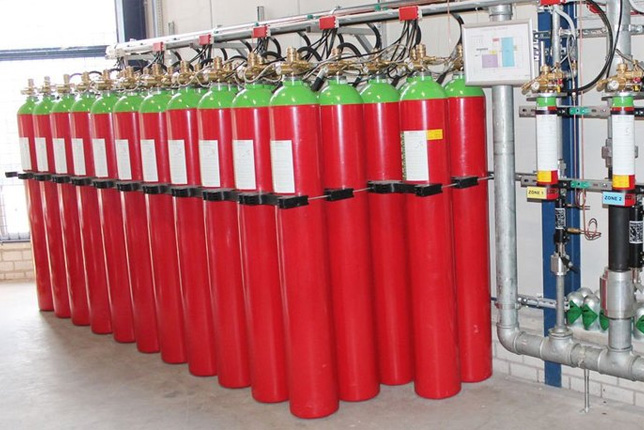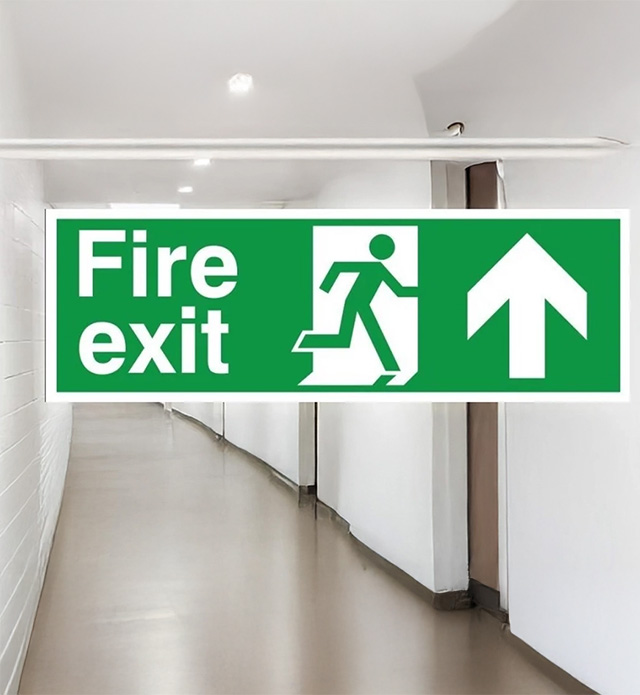Gas Suppression System
Introduction to Gas Suppression System
A gas suppression system is a fire protection mechanism designed to extinguish fires by releasing a specialized gas that reduces oxygen levels, interrupts the chemical reaction of the fire, or cools the surrounding environment. These systems are commonly used in areas where water-based suppression could cause damage, such as data centers, server rooms, libraries, museums, and industrial facilities with sensitive equipment. Gas suppression systems utilize agents like FM-200, CO₂, Inergen, or Novec 1230, each selected based on the application and potential fire risks. The system activates automatically through heat or smoke detection, ensuring rapid response and minimal disruption. By effectively suppressing fires without leaving residue or requiring extensive cleanup, gas suppression systems provide reliable and efficient fire protection for critical assets.
Different technologies to extinguish fire depending on the occupancy and type of fire is as follows.
Standards Followed
The Indian Standards (IS) for fire safety and gas suppression systems are established by the Bureau of Indian Standards (BIS) to ensure the safety and reliability of fire protection mechanisms. These standards cover various aspects, including design, installation, maintenance, and performance of fire suppression systems. IS 15105:2002 is a key standard related to gas-based fire suppression, ensuring compliance with safety protocols in commercial and industrial applications.
The National Building Code (NBC) of India provides comprehensive guidelines for fire safety, including fire suppression systems. It categorizes buildings based on occupancy and prescribes the necessary fire protection measures. Part 4 of the NBC specifically addresses fire and life safety, recommending gas suppression systems for areas where water-based suppression is unsuitable, such as data centers and electrical rooms.
The National Fire Protection Association (NFPA) is a globally recognized organization that develops fire safety standards, including those for gas suppression systems. NFPA 2001 is a crucial standard governing clean agent fire suppression systems, ensuring effective fire control without damaging sensitive equipment. NFPA standards are widely adopted for their rigorous safety and performance requirements.
The British Standards (BS) set by the British Standards Institution (BSI) provide fire protection guidelines widely used in the UK and internationally. BS EN 15004 is a significant standard covering gaseous fire suppression systems, aligning with international best practices. These standards ensure that suppression systems meet high safety, reliability, and environmental impact criteria.
FM Global (Factory Mutual) and UL (Underwriters Laboratories) are independent organizations that certify fire suppression systems for quality, reliability, and effectiveness. FM-approved and UL-listed gas suppression systems meet stringent testing criteria, ensuring they function efficiently in real-world fire scenarios. Compliance with these certifications assures businesses and industries of the highest safety and performance standards.
Service Industry
- Commercial
- Residential
- Institutional
- Assembly
- Business
- Hospital
- Educational
- Industrial
- Mercantile
The above inclusive of the Office building ,Shopping centers, Mall, Auditorium, Banks, Hotels, Residences, Laboratories, Hospitals, Colleges, Dormitory blocks, Factories, Ware houses, Server room, Electrical equipment blocks.
FM-200 and NAF S-III Fire Suppression Systems
FM-200 and NAF S-III are clean agent fire suppression systems designed to protect critical assets and spaces where water-based fire suppression is not suitable. FM-200 (Heptafluoropropane) is a widely used, fast-acting gaseous fire suppressant that quickly extinguishes fires by absorbing heat without leaving residue or harming electronic equipment. It is safe for occupied spaces and environmentally friendly with a low atmospheric lifetime. NAF S-III is another clean agent fire suppressant with similar fire-extinguishing properties but with a lower environmental impact. It effectively suppresses Class A, B, and C fires without causing damage to sensitive equipment. Both systems are commonly used in data centers, control rooms, museums, and other critical areas where rapid fire suppression is essential. Regular maintenance and proper system design are crucial to ensuring their effectiveness in an emergency.
FM-200 and NAF S-III Fire Suppression Systems

INERGEN Gas Suppression System

INERGEN Gas Suppression System
The INERGEN gas suppression system is a clean agent fire suppression solution designed to protect critical areas where traditional water-based systems may cause damage. INERGEN is composed of natural gases—52% nitrogen, 40% argon, and 8% carbon dioxide—making it environmentally friendly and safe for occupied spaces. It extinguishes fires by reducing oxygen levels to a point where combustion cannot be sustained while ensuring sufficient oxygen remains for human safety. Unlike chemical-based agents, INERGEN leaves no residue, making it ideal for protecting sensitive equipment in data centers, control rooms, museums, and archives. This system is highly reliable, requires minimal maintenance, and complies with fire safety standards, making it an effective choice for critical fire protection needs.
Novec Gas Suppression System
The Novec 1230 Fire Suppression System is a clean agent fire protection solution designed for rapid fire extinguishment without causing damage to sensitive equipment or the environment. Novec 1230 fluid, a fluoroketone-based compound, works by absorbing heat and disrupting the fire’s chemical reaction, effectively suppressing Class A, B, and C fires. Unlike water-based systems, it leaves no residue and requires no cleanup, making it ideal for data centers, server rooms, museums, and other critical facilities. Novec 1230 is non-conductive, safe for occupied spaces, and has a low environmental impact with zero ozone depletion potential and a short atmospheric lifetime. Its fast-acting suppression capability ensures minimal downtime and asset protection, making it a reliable choice for fire safety in high-value environments.
Novec Gas Suppression System

Scope of our Work:
- Preliminary site visit and discussion with Architect / Client and project feasibility survey.
- Necessary NOC drawings with document (No objection certificate). (For base building projects).
- Preparation of Preliminary design Brief (DBR) with Schematic.
- Preparation of Preliminary designs for the Client / Architects approval of comments if any, by way of drawings to explain the general planning and nature of works with the basic dimensions, inclusive of basic requirement for the safety & security systems shafts etc and other features required for services. Obtaining the approval of the Client / Architect.
- Making Technical specification, Bill of Quantity & Tender Layout (For better understanding of our requirement).
- Provided the Estimated Bill of quantity for client to get idea for budgeting.
- Preparing & floating the tender enquiry with tender drawing for system.
- Scrutinizing & comparing the offers of various bidders.
- Providing assistance to client in negotiation and finalizing of the contractors.
- Coordinating the overall designing with other services i.e. HVAC, ELECTRICAL, FIRE FIGHTING & LOW CURRENT systems and preparing the detail section which will be useful for Vendor & PMC to run the project in smooth way and without any issues of installation on site.
- Our support will extend unto preparation of the above false ceiling coordination & False ceiling coordination layouts.
- Describe the requirement of our system to the vendor in the kick off meeting with the Good for construction layout (GFC).
- Checking and approving the shop layout submitted by the vendors.
- Periodical visits to the site of work during the execution to ensure that the intent of the drawings is duly carried out and that technical features envisaged by the consultant are properly executed.
- Generate the site visit report with proper snap shots to reduce the uncertainty of installation. This will help to avoid rework during the commissioning stage.
- Provide necessary test certificate format and witnessing the performance test for all the involved systems.
- We ensure to obtain ideal Handing over procedure.




